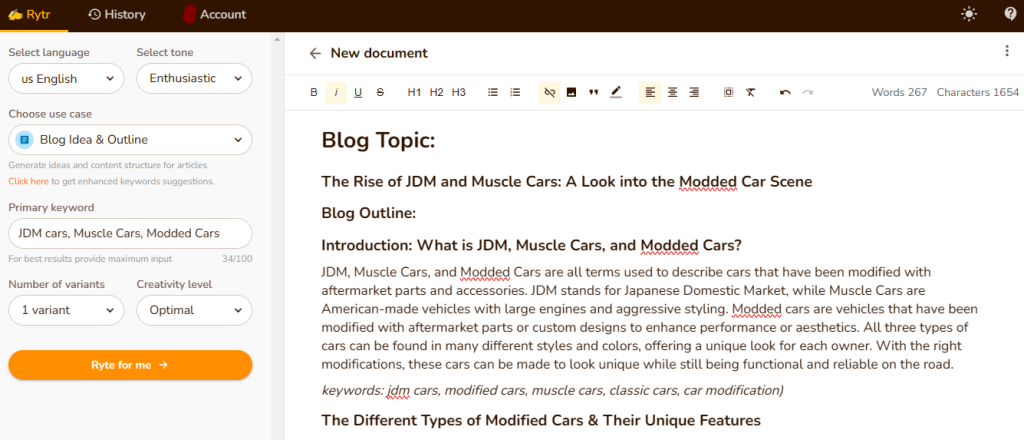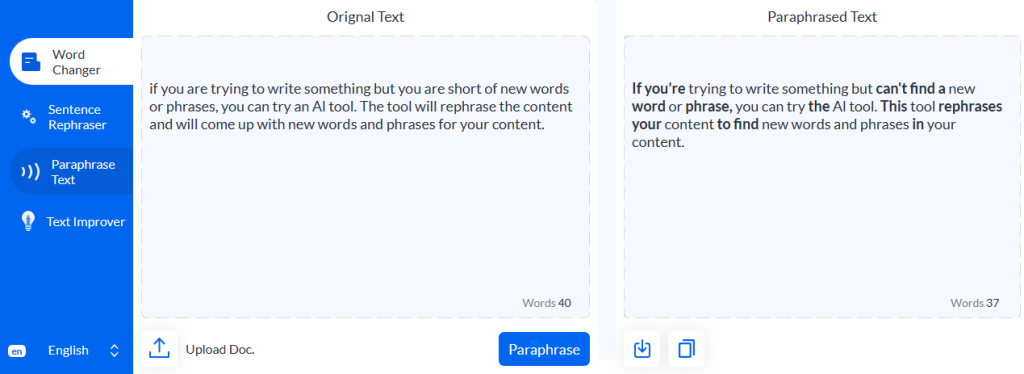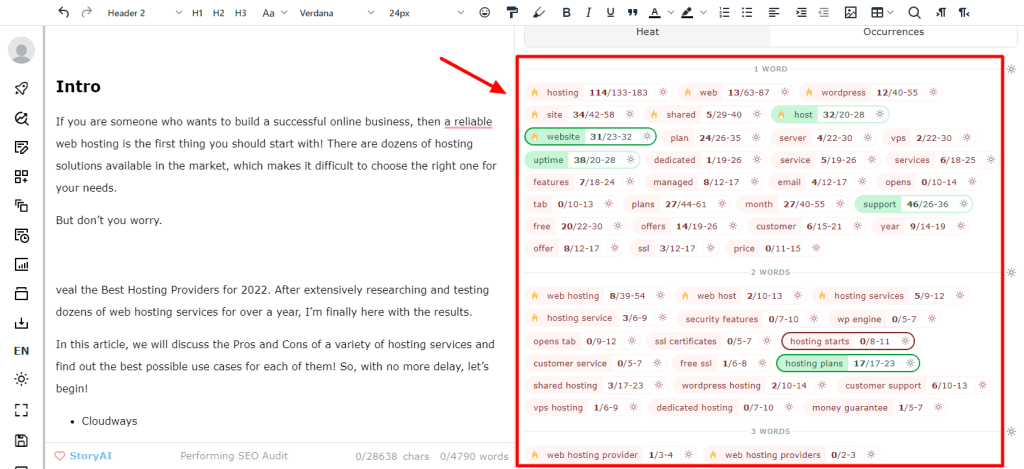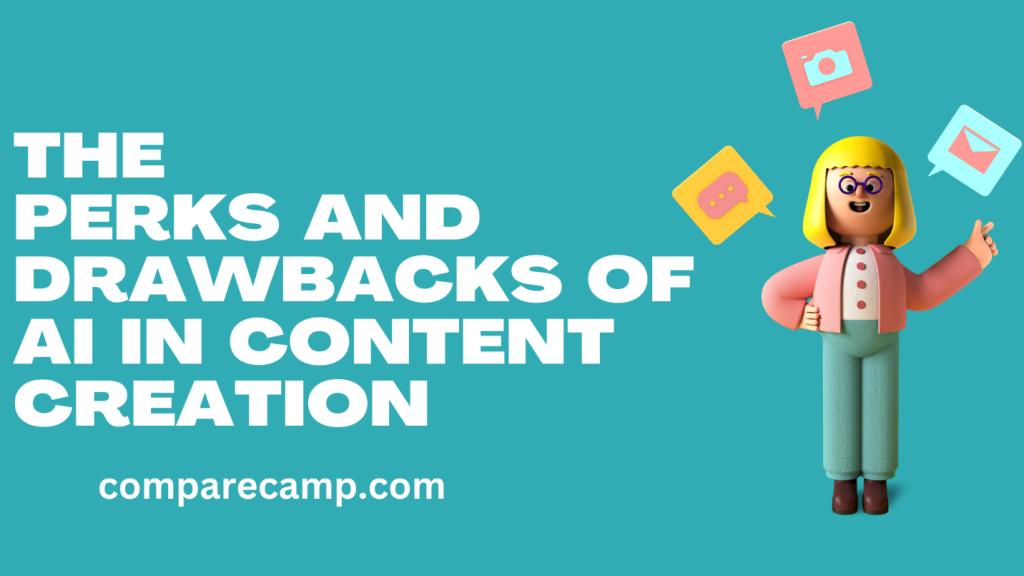The use of artificial intelligence (AI) in content creation is becoming increasingly popular. AI can help to automate and streamline the process, allowing companies to create content faster, more accurately, and with greater quality.
However, some potential drawbacks to AI need to be considered before implementation. In this article, we will be looking at some of those. We’ll start with the benefits.
Benefits of AI in Content Creation
Increased Efficiency
Efficiency is the measure of how quickly and effectively content is created. AI can help increase efficiency by automating (partially, if not fully) certain processes, such as research and keyword optimization. This reduces the amount of time and effort needed.
AI helps automate various steps that would otherwise take a long time to complete manually. When it comes to research, for example, a very common instance of this can be seen in tools like Moz and Ahrefs. Based on a single command, these types of tools provide a whole galore of data including keywords, secondary keywords, popular FAQs, and whatnot.
On the other hand, some tools like ChatGPT and Rytr can generate whole pieces of content by working on an initial prompt. In other words, you can provide them with keywords or small descriptions that they can use to create an entire blog post or article.
Here is what that looks like:

Source: https://app.rytr.me

Source: https://chat.openai.com/
As you can see, to create an article in Rytr, we have to provide it with some keywords. We used the words “JDM cars”, “Muscle Cars”, and “Modded Cars.” The tool provided us with a comprehensive outline along with content.
For ChatGPT, we just had to ask it using a question. The question we used was “can you tell me about JDM cars”. It gave us a concise article all on its own.
In both cases, we had to wait less than a minute, and that speaks volumes for their efficiency.
Improved Accuracy
When it comes to talking about content accuracy, we refer to how accurate it is vis-à-vis its grammar, spelling, punctuation, and information. AI can help improve accuracy by automatically checking for errors and providing feedback on the write-ups.
For example, an AI-powered spell-checker can automatically detect spelling errors in the write-ups and provide feedback on how to correct them. This eliminates the need for manual proofreading, which can save time and improve accuracy.
An excellent example of this is a tool like Grammarly. Grammarly can spot the grammar and spelling errors in the content and then provide the correct suggestions when they (the errors) are clicked.

Source: https://www.grammarly.com/
Using tools like these saves an incredible amount of both time and effort. For example, with the Grammarly extension for Windows, Word, and Web, you can catch errors as soon as you make them. This helps you to write correctly all the time.
Improved Quality of Content
Content quality is the degree to which is well-written, engaging, and informative. It must be of high quality to attract and retain readers. AI can help improve the quality and makes it easy to read.
For example, if you are trying to write something but you are short of new words or phrases, you can try an AI tool. The tool will rephrase the text and will come up with new words and phrases.
A good example of such tools are paraphrasers like Paraphraser and Paraphraseonline.

Source: https://www.paraphraser.io/

Source: https://www.paraphraseonline.io/
In these examples, we can see that the tools have changed a few words here and there. They add some new words, and replace a few. It results in an overall passage that is easier to read, still provides the same information.
Reduced Cost of Content Creation
Content cost is the measure of how much money is spent on creating content. These are the spending on purchasing different tools and getting subscriptions for improving the quality.
For example, when you have to create content the normal way, you have to pay for writers and editors. You also have to cough up the monthly subscriptions for expensive tools like Ahrefs and Moz when you have to do research.
With AI tools, you can cut down on all this expense if you just invest in a one-in-all type of tool such as Closerscopy.

Source: https://www.closerscopy.com/
Investing in one tool is much cheaper than investing in three different tools that perform one specific function. Closerscopy is just one example, there exist many toolkits that can provide you with a comprehensive content optimization solution. They can also provide you with keywords, and insights into what kind of content is trending right now.
Drawbacks of AI in Content Creation
Lack of Human Element
The human element in content creation is the creativity and personal touch that comes from a human author. This human element is necessary for the content to be engaging.
When AI is used for creating content, the human element is lost, which leads to it (the content) gaining a mechanical and robotic feel.
That’s because AI is cannot realize what is “emotion”, it can only mimic it at best. Since it does not understand emotion, it cannot utilize it properly. That’s why you can see that most content created using AI is either overly formal or lacks emotional depth.
Difficulties with Interpretation
Interpretation is the process of understanding and making sense of the content. It must be properly interpreted for it to be effective.
Content created by AI can be difficult to understand and may not accurately reflect the original intent of the writer.
AI cannot provide the understanding and insight that is needed to properly interpret the text. It cannot interpret the nuances of language, which can be confusing or inaccurate for the reader.
Another issue is that AI-generated content can claim things and provide facts and figures without any evidence. Sometimes these claims can prove to be false. So, it’s not a good idea to completely rely on AI.
Limited Capacity to Adapt and Improve
AI-generated content can be limited in its ability to adapt to changing conditions, trends, or circumstances.
This means that they can struggle to keep up with the ever-evolving content landscape. This can lead to text becoming outdated or irrelevant over time.
Our best example for this scenario is ChatGPT. ChatGPT is a revolutionary AI chatbot, however, OpenAI has informed its users that its database is limited to 2021. This means that ChatGPT cannot create content about recent events, or know of any information that was made known after 2021.
Google is trying to create its own chatbot called Bard. They claim it will always have access to the latest information and use it for formulating proper responses. From what we have seen so far, they have not been too successful. That’s why in the near future, we can still expect AI to have this limitation.
Final Thought
The potential of artificial intelligence to revolutionize content creation is undeniable. AI can bring about immense advantages, such as increased efficiency, improved accuracy, and decreased costs.
However, as with all new technologies, there are some drawbacks, such as the limited capacity to adapt and improve. Ultimately, it is up to us to ensure that AI is implemented safely and responsibly to fulfill the promise of AI in content creation.

